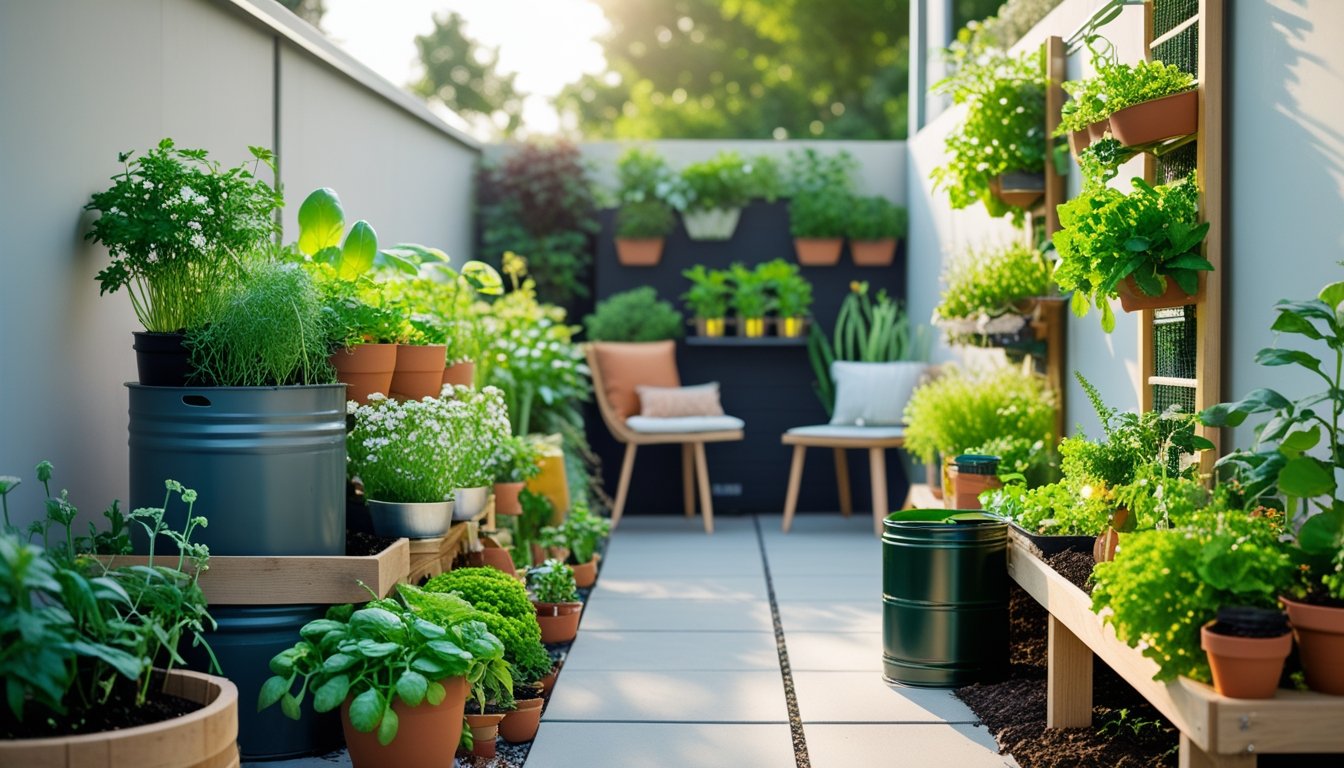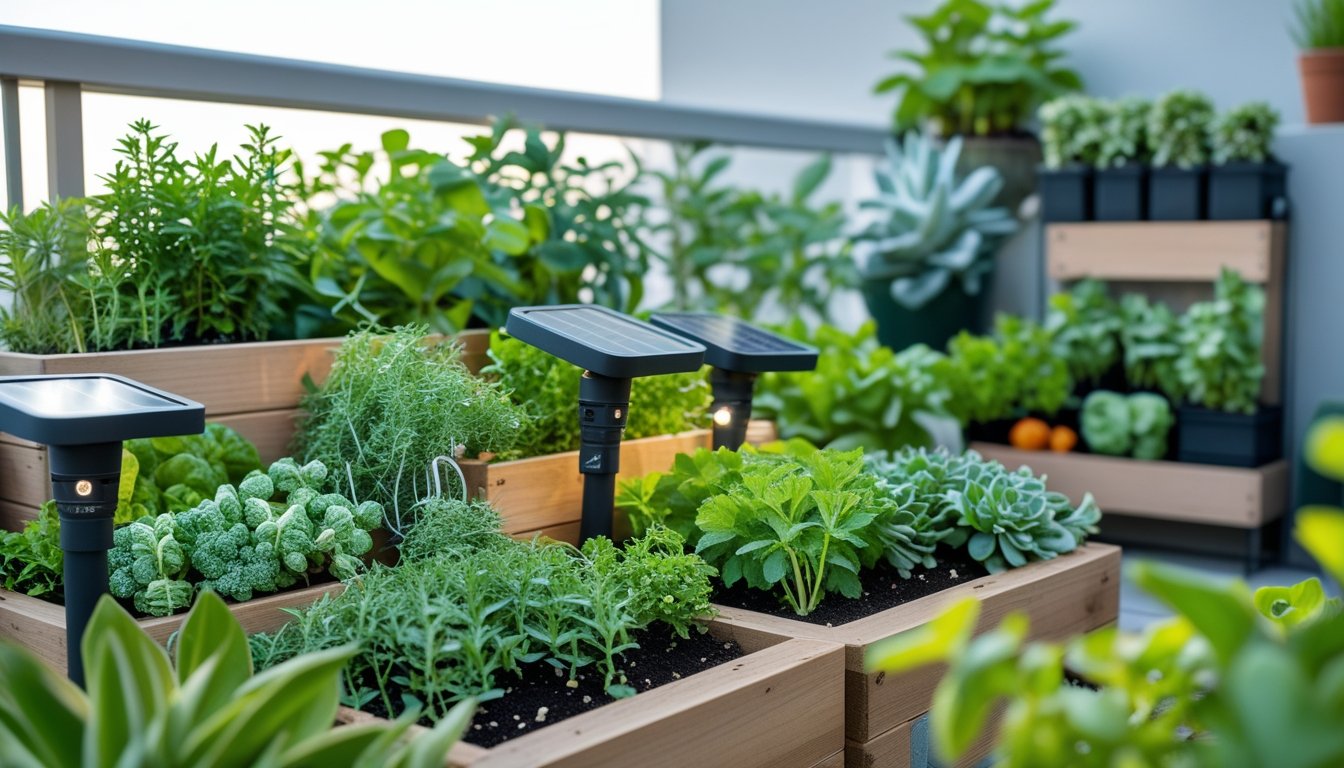Late updated: 01 Jun 2025 15:06
Written by: James Whitaker
Sustainable Garden Design Tips For Small Spaces: Maximising Eco-Friendly Urban Living
Creating a beautiful garden doesn't require a vast expanse of land. Even with limited space, we can design a thriving garden that is both visually pleasing and environmentally responsible. Embracing sustainable gardening principles in small spaces allows us to maximise the use of limited areas while preserving natural resources.

Incorporating sustainable techniques not only benefits the environment but also enhances the health and longevity of our plants. We can utilise container gardening for its flexibility and ease of rearrangement to ensure plants receive adequate sunlight. By leveraging vertical gardening, we optimise limited space and create vibrant displays that catch the eye.
Our mission is to inspire and guide readers through the essentials of small-space sustainable gardening. From selecting the appropriate plant varieties to implementing resource-efficient practices, we have the opportunity to create gardens that are both beautiful and sustainable.
Key Takeaways
- Sustainable gardening in small spaces maximises limited area.
- Vertical and container gardening enhance plant health.
- Creative design elements can boost visual appeal.
Foundations of Sustainable Garden Design for Small Spaces

Focusing on plant selection, incorporating native species, and maximising outdoor space through hardscaping are critical in the sustainable design of small gardens. These strategies ensure we make efficient use of limited space while promoting biodiversity and conserving resources.
Choosing the Right Plant Selection
Selecting the correct plants for our small space is crucial for sustainability. Compact and multi-purpose plants are ideal, offering aesthetic value and sometimes edible yields. For example, herbs like thyme or rosemary serve both culinary and decorative functions. Vertical gardening can also optimise space – consider climbers like ivy or compact fruit trees trained against a wall. This approach utilises every inch wisely and fosters a richer plant diversity in restricted areas.
Incorporating Native Plants and Drought-Tolerant Species
Integrating native plants into our small garden design provides numerous benefits. They are well-suited to local conditions and often require less maintenance than exotic species. Drought-tolerant plants such as lavender or succulents minimise water usage, crucial in creating an eco-friendly garden. Native flora offers support to local wildlife, attracting bees and butterflies. This strengthens the ecosystem and adds vibrancy to our garden.
Maximising Outdoor Space with Hardscaping
Hardscaping elements, like pathways and raised beds, play an essential role in maximising our garden's layout. Raised beds can create layers, adding depth and facilitating diverse plantings. Thoughtfully placed paths delineate different areas, allowing optimised use of limited space. Materials like reclaimed wood or permeable pavers contribute to sustainability. These features not only enhance functionality but also reduce environmental impact, making them an integral part of our design strategy.
Creative Tips for Sustainable Features and Year-Round Interest

In enhancing small garden spaces sustainably, incorporating ornamental grasses as focal points, cultivating compact vegetable and herb gardens, and drawing insights from landscape architects are effective tactics. Each approach helps maintain visual and functional interest throughout the year.
Creating a Focal Point with Ornamental Grasses
Ornamental grasses add both structure and movement to small gardens. Their varied textures and colours can create lively focal points. Grasses like Miscanthus or Pennisetum stand out with their elegant plumes and durable foliage, providing beauty even in winter.
These grasses are low-maintenance and drought-resistant, making them an eco-friendly choice. Placing them strategically can accentuate paths or borders, while also offering habitats for wildlife. Grouping different varieties can enhance diversity and interest.
Incorporating native grasses supports local ecosystems. Native species tend to thrive with minimal intervention, reducing our need for chemical treatments.
Designing a Compact Vegetable Garden and Herb Area
A well-planned vegetable and herb garden maximises productivity in limited spaces. Vertical gardening methods, such as trellises and stackable planters, optimise area use while allowing for variety. We can grow basil, lettuce, and more, enhancing our culinary options right from our garden.
Interplanting vegetables with aromatic herbs like rosemary or chives deters pests naturally. This reduces reliance on pesticides, promoting healthier growth. Companion planting also encourages biodiversity.
Using raised beds helps manage soil quality and drainage, key factors for a thriving garden. Selecting fast-growing varieties ensures crops are ready for multiple harvests throughout growing seasons. This strategy keeps our garden productive and interesting all year round.
Adapting Expert Insights from a Landscape Architect
Landscape architects provide valuable perspectives for transforming small spaces. Their expertise in spatial design and sustainable practices guides us in creating areas that are both beautiful and functional. They often recommend integrating hardscape elements like permeable pathways or small retaining walls to define zones and reduce maintenance.
Selecting plant species that bloom in different seasons ensures continuous visual appeal. Layering plant heights creates depth, making gardens appear larger. With their advice, we can also incorporate water-saving technologies, like drip irrigation, to conserve resources effectively.
Collaborating with a professional allows us to leverage their creativity and technical knowledge. This ensures our garden maintains its charm and sustainability year-round.
Frequently Asked Questions

Efficiently designing small gardens requires intentional choices about maintenance, sustainability, and modern aesthetics. Optimising space and energy use while being mindful of budget constraints is paramount to achieving a sustainable and pleasing garden.
How can one implement low-maintenance design strategies in small gardens?
Incorporating perennial plants can significantly reduce the need for replanting each year. Utilising native flora can ease maintenance challenges, as these plants tend to require fewer resources and less intervention. Automated irrigation systems help maintain a sustainable moisture level with minimal effort.
What are effective techniques for gardening without grass in limited areas?
Replacing grass with ground cover plants can create a lush appearance without the upkeep required by traditional lawns. Mulching is another effective technique, helping to retain moisture and suppress weeds. Using decorative stones or pavers can enhance functionality and aesthetic appeal in grassless gardens.
In what ways can sustainability be prioritised on a budget in a small garden?
Repurposing items like wooden pallets or scrap metal for planter boxes can save money and reduce waste. Composting kitchen scraps is an economical way to fertilise the garden naturally. Harvesting rainwater or using a simple greywater system helps conserve water resources economically.
What are key considerations for creating a modern garden in a confined space?
Minimalist designs often work best in limited areas by focusing on simple lines and shapes. The use of monochrome colours or a limited palette ensures a cohesive look. Incorporating reflective surfaces like mirrors can create the illusion of a larger space.
How can vertical gardening be utilised to enhance sustainability in small spaces?
Vertical gardening makes use of structures such as trellises, hanging pots, and green walls to maximise planting area. Climbing plants or vines can offer both aesthetic appeal and functional shade. These strategies allow for a greater variety of plants without increasing the garden's footprint.
What principles should be followed when designing a compact yet efficient garden?
Planning is crucial; mapping out the garden's layout can help maximise functionality. Our designs should prioritise multipurpose elements, like convertible furniture that doubles as storage. Additionally, selecting plant species that thrive in local environmental conditions ensures efficient resource use and minimal intervention.
